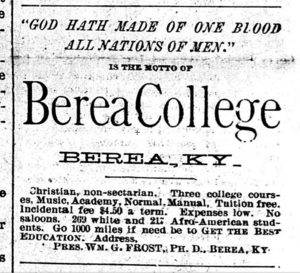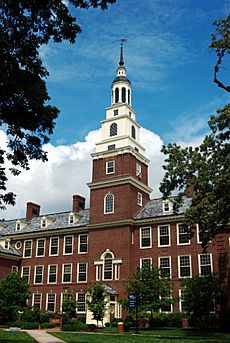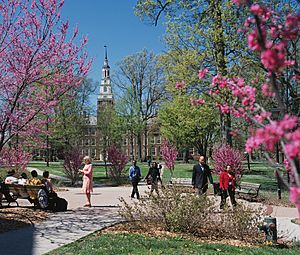Berea College facts for kids
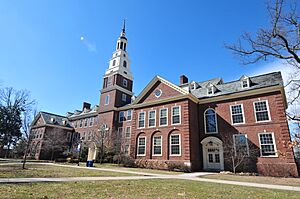 |
|
| Motto | God has made of one blood all peoples of the earth. |
|---|---|
| Type | Private liberal arts work college |
| Established | 1855 |
|
Academic affiliations
|
Space-grant |
| Endowment | $1.7 billion (2024) |
| President | Cheryl L. Nixon |
|
Academic staff
|
139 |
| Undergraduates | 1,454 |
| Location |
,
,
United States
37°34′23″N 84°17′31″W / 37.573°N 84.292°W |
| Campus | Exurban (140 acres) |
| Colors | (Blue and white) |
| Nickname | Mountaineers |
|
Sporting affiliations
|
NCAA Division III—HCAC |
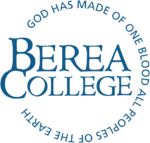 |
|
Berea College is a special private college in Berea, Kentucky. It's known as a liberal arts and work college. This means students learn a wide range of subjects, and they also work jobs on campus.
The college was started in 1855. It was the first college in the Southern United States to welcome both boys and girls, and students of all races. It was integrated from 1866 until 1904, and then again after 1954.
Berea College helps students pay for their education. It uses special programs and scholarships to cover tuition fees. Many students come from the Appalachian region, but others come from over 40 U.S. states and 70 different countries. About half of the students are people of color.
Berea offers 33 different subjects you can major in. All students must work at least 10 hours a week for the college. This helps them learn important skills and also helps pay for their education.
Contents
History of Berea College
Berea College was founded in 1855 by John Gregg Fee. He was an abolitionist, which means he was against slavery. Fee wanted to create a school where Black and white students could learn together. This was very unusual at the time. It made Berea the first non-segregated (meaning not separated by race) and coeducational (meaning for both boys and girls) college in the South.
The college started as a small, one-room school. It was also used as a church on Sundays. The land for the school was given to Fee by another abolitionist, Cassius Marcellus Clay. Fee named the community after a place called Berea in the Bible.
In 1859, the school officially became a college. However, people who supported slavery forced Fee and the teachers to leave the area that same year.
During the American Civil War, Fee worked to raise money for the school. He also helped freed slaves and their families at a place called Camp Nelson. He helped build places for them to live, a hospital, a school, and a church.
After the war, in 1866, Berea College had 187 students. About half were Black and half were white. The college started offering classes to prepare students for college-level studies. In 1869, the first college students were accepted. The first bachelor's degrees were given out in 1873.
Most colleges in the South were segregated by race. Berea was different until 1904. A new state law, called the Day Law, forced the college to become an all-white school. Berea College tried to fight this law in court, but they lost. So, the college had to stop admitting Black students.
To help Black students get an education, Berea College raised money to start the Lincoln Institute in 1912. This new school was for Black students. In 1950, the Day Law was changed. This allowed colleges to be integrated again. Berea College quickly went back to its policy of welcoming students of all races.
During World War II, Berea was one of many colleges that helped train students for the Navy. In 1968, Berea stopped offering classes for younger students. It decided to focus only on college-level education.
College Presidents
| Name | Years as president | |
|---|---|---|
| 1 | Henry Fairchild | (1869–1889) |
| 2 | William Boyd Stewart | (1890–1892) |
| 3 | William Goodell Frost | (1892–1920) |
| 4 | William J. Hutchins | (1920–1939) |
| 5 | Francis S. Hutchins | (1939–1967) |
| 6 | Willis D. Weatherford | (1967–1984) |
| 7 | John B. Stephenson | (1984–1994) |
| 8 | Larry Shinn | (1994–2012) |
| 9 | Lyle D. Roelofs | (2012–2023) |
| 10 | Cheryl Nixon | (2023–Present) |
Academics at Berea
Berea College offers 33 main subjects (majors) and 39 smaller subjects (minors). Students can choose what they want to study. If a student wants to study something not offered, they can create their own major. They just need to meet certain rules and get help from teachers.
Some of the most popular majors in 2021 were:
- Business Administration and Management
- Computer and Information Sciences
- Biology/Biological Sciences
- Psychology
- Human Development and Family Studies
- Mass Communication/Media Studies
- Engineering Technologies/Technicians
- Political Science and Government
Berea College helps students study abroad in other countries. This gives them a chance to experience different cultures. Students can also apply for the Thomas J. Watson Fellowship. This scholarship helps them study abroad for a year after they graduate.
Berea uses a "course credit" system instead of semester hours. One Berea course credit is like four semester hours. Students must take at least 3.00 course credits to be considered full-time. This is like 12 semester hours.
All students must go to at least seven "convocation" events each semester. These events are like special lectures, concerts, or performances. They are designed to help students learn new things and experience different cultures. These events are free for students and open to the public.
College Rankings
| USNWR Liberal Arts College | 40 |
|---|---|
| Washington Monthly Liberal Arts | 2 |
| Forbes | 453 |
Berea College is often ranked very highly. In 2024, Washington Monthly ranked Berea College first among national liberal arts colleges. They looked at how much colleges help society. This includes helping students from all backgrounds succeed (social mobility).
The New York Times also ranked Berea first in 2023 for how well it helps students from different economic backgrounds. U.S. News & World Report ranked Berea 40th overall among liberal arts colleges in 2025. They also ranked it first for "Service Learning" and second for "Most Innovative Schools."
After ten years, Berea College graduates earn a median salary of $40,000. This means half earn more and half earn less. About 51% of Berea graduates earn more than a typical high school graduate from their area.
Scholarships and Work Program
Berea College is unique because it gives all students a full-tuition scholarship. This means students don't pay for their classes. Many students also get help with room and board (living and food costs).
Students are only accepted if they need financial help. Usually, this means their family income is in the lowest 40% of U.S. households. About 75% of new students come from the Appalachian region. About 8% are international students. Usually, only one student from each country is accepted each year. This helps make sure students from many different countries are at the college. All international students also get full scholarships.
Berea College has a large amount of money saved up, called an endowment. This money helps pay for the scholarships. The endowment was $1.6 billion in 2021. This money comes from donations from former students and other supporters.
As a work college, Berea requires all students to work on campus. They work 10 or more hours each week. Berea is one of only nine colleges in the U.S. with this kind of mandatory work program.
Students can work in many different jobs. They might bus tables at the Boone Tavern Hotel, which the college owns. They might give tours, or make brooms, pottery, or woven items in Student Craft. Other jobs include cleaning, helping in offices, gardening, or working in the computer labs. This work program helps students learn job skills. It also helps the town of Berea become known for its arts and crafts.
As of 2022, students are paid an hourly wage for their work. The pay ranges from $5.60 to $8.60 per hour. Students are not allowed to work off-campus jobs. This is because their schoolwork and campus job take up a lot of time.
Folk Dance
Berea College is famous for its folk dance programs. Students learn different types of dances like square dance, contra dance, and English country dance. The college often has community folk dances on weekends. There are also ten different dance groups on campus, including Middle Eastern, Swing, Latino, African, and hip hop. You can even get a minor in dance.
Folk dance came to Berea in the 1920s. The Berea College Country Dancers group started in 1938. The college also holds an annual Christmas Country Dance School. Many famous dancers and callers got their start at Berea.
Christian Identity
Berea College was founded by Protestant Christians. It is a Christian college, but it doesn't belong to one specific Christian group. The college's motto is: "God has made of one blood all peoples of the earth." This comes from the Bible (Acts 17:26).
Every student must take a class about Christian faith. These classes are taught in a way that respects everyone's beliefs. This is true no matter what religion a student follows.
Library Collections
The Hutchins Library at Berea College has a large collection of books, old documents, and music. These items are all about the history and culture of the Southern Appalachian region. The Southern Appalachian Archives has records, personal papers, and photos. This includes important documents from groups like the Council of the Southern Mountains.
Student Life
| Race and ethnicity | Total | ||
|---|---|---|---|
| White | 44% |
|
|
| Black | 19% |
|
|
| Hispanic | 15% |
|
|
| Other | 10% |
|
|
| Foreign national | 8% |
|
|
| Asian | 4% |
|
|
| Economic diversity | |||
| Low-income | 82% |
|
|
| Affluent | 18% |
|
|
Since 2002, all students at Berea have received laptop computers. They get to keep these computers when they graduate. Students don't have to pay for the computers themselves. They just pay a small fee to help with the college's technology.
Students need a special permit to have a car on campus. It's usually hard for first- or second-year students to get these permits.
Berea College has two unique holidays. Since 1875, they celebrate Mountain Day. On this day, students don't have classes. They go on a sunrise hike to the top of Pinnacle Mountain. They also enjoy games, performances, and food.
Another special day is Labor Day. This holiday started in 1921. On Labor Day, the campus takes a break from classes. It's a day to celebrate the importance of student work. It also helps students find jobs for the next school year. And it helps graduating students get ready for life after college.
Athletics
Berea College sports teams are called the Mountaineers. They are part of NCAA Division III. This means they don't offer sports scholarships.
The Mountaineers joined the Heartland Collegiate Athletic Conference (HCAC) in July 2024. Before that, they were in the Collegiate Conference of the South (CCS) for two years. They have also been part of other conferences in the past.
Berea competes in 14 different sports. Men's sports include baseball, basketball, cross country, golf, soccer, tennis, and track & field. Women's sports include basketball, cross country, soccer, softball, tennis, track & field, and volleyball.
Men's Basketball History
On February 4, 1954, a player named Irvine Shanks played for Berea. He helped break the color barrier in college basketball in Kentucky. This means he was one of the first Black players to play in a college basketball game in the state.
Notable People from Berea College
Many interesting people have studied or taught at Berea College. Here are a few:
- A. A. Burleigh – The first African American adult to graduate from Berea College in 1875.
- John Fenn – A scientist who won the Nobel Prize in Chemistry in 2002.
- Derby Chukwudi - Miss New Jersey USA 2023.
- Alix E. Harrow — A science fiction writer who won a Hugo Award in 2019.
- bell hooks (Gloria Jean Watkins) – A famous author and professor who wrote many books.
- Julia Britton Hooks – One of the first African-American women to graduate from college in the U.S.
- Juanita M. Kreps – She was the U.S. Secretary of Commerce under President Jimmy Carter.
- W. Gyude Moore - A Liberian Minister of Public Works.
- Jeffrey Reddick – An American writer who created the Final Destination movie series.
- Jack Roush – The founder and owner of Roush Fenway Racing, a NASCAR team.
- Tijan Sallah - A poet and economist from Gambia who works at the World Bank.
- Carter G. Woodson – An important African American historian. He helped start Black History Month.


